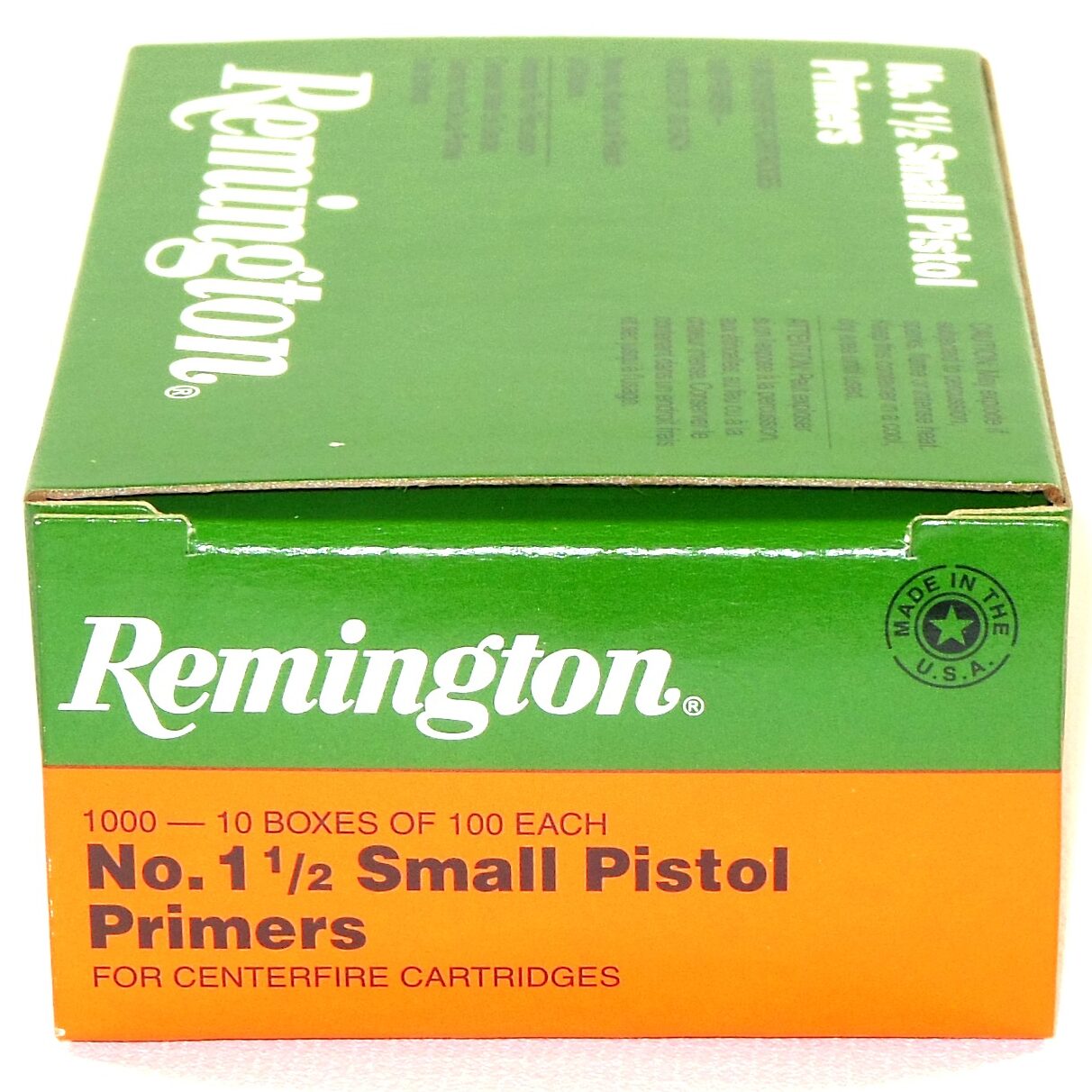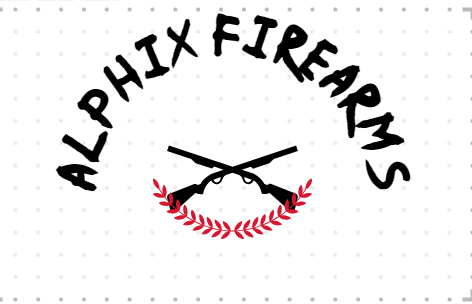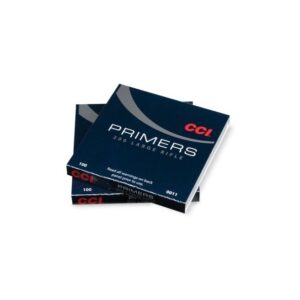Description
Remington Small Pistol Primers
Remington Small Pistol Primers industries, Remington understands how critical it is to have the best quality ammunition available in order for your rifle to function to its maximum potential whether hunting or shooting.
This begins with the use of the highest-quality components available in the ammunition manufacturing process. These are the exact primers ( Remington Small Pistol Primers ) that Remington use in the manufacture of their own ammunition, and they perform to the highest of industry expectations. You must start with the best if you want the most performance out of your handgun, which is why reloaders pick Remington ( Remington Small Pistol Primers ) components for their loads.

Every Remington Small Pistol Primers is made up of a number of subcomponents that have been built to extremely tight tolerances. The dimensions of the primer cup are regulated to.0001″, and the priming mix has been precisely prepared to provide consistent ignition with a broad variety of powder kinds and compositions.
Primers ( Remington Small Pistol Primers ) are subjected to reliability testing at temperatures ranging from -20 degrees F to +150 degrees F. The unusual tripod anvil design produces a bigger strike area while maintaining optimum sensitivity, even when the firing pin impacts off center of the anvil.

Remington’s 1½ pistol primers are somewhat unique in the world of small pistol primers. Remington Small Pistol Primers are the only tiny pistol primer I’m aware of that comes with a warning about using them in specified handgun calibers, and they are also the most expensive. The majority of small pistol primers are available in two varieties: regular and magnum, and their use is usually dictated by the type of powder being used.
Similarly, most pistol powders are sufficiently lit by ordinary primers, however other pistol powders, such as ball powders such as Hodgdon H110 and Winchester 296 for example, benefit from the additional spark provided by magnum primers in order to burn more effectively. Standard primers for powders a, b, and c, and magnum primers ( Remington Small Pistol Primers ) for powders x, y, and z, may be used interchangeably and are simple to learn.

Remington Small Pistol Primers 112 and 512 small pistol primers, on the other hand, do not necessarily fit into the standard vs magnum category that differs between different types of gunpowder. In addition, there is an unique notice on the 112 primer box stating that they are not suited for use with certain high pressure cartridges.
“Do not use 112 tiny pistol primers in high-intensity pistol cartridges such as the.357 Magnum,.357 SIG, and the.40 S&W,” the caution states. It is possible that your firearm could be damaged, as well as that you will sustain physical injury.” “Call Remington Arms at 800-243-9700 for a free catalog, or visit our website at www.remington.com,” the warning states further. The catalog ballistics tables include a list of the primers that are recommended for each cartridge.”

To be sure, Remington’s ballistic tables include information on the appropriate primers for each caliber that Remington loads, including pistol and rifle calibers. Among the 112 primers mentioned are those for the 25 Auto,.32 S&W,.32 S&W Long (longer),.32 Auto,.380 Auto (auto),.38 S&W (short colt),.38 Special, and.38 S&W (short colt). None of these cartridges exceeds the maximum chamber pressure limitations of 25,000 psi.
In a surprising turn of events, the 112 primer ( Remington Small Pistol Primers ) is listed for the 9mm Luger, the 9mm +P, and the.38 Super cartridges. These latter calibers do not have a low pressure rating. The SAAMI (Sporting Arms and Ammunition Manufacturers’ Institute) pressure limit for the 9mm Luger is 35,000 pounds per square inch, and the limit for the +P variant is 38,500 pounds per square inch.

The SAAMI pressure limit for the.38 Super is 36,500 pounds per square inch. These figures compare to the pressure limits of 35,000 psi for the.357 Magnum and.40 S&W cartridges, and 40,000 psi for the.357 SIG cartridge. Is it really possible that the 112 primer is not acceptable for the.357 Magnum and.40 S&W when those calibers have similar—if not higher—pressure limits? What about the 9mm, 9mm +P, and.38 Super, which have similar—if not higher—pressure limits?
Some reloaders, including myself, have become perplexed as a result of this. In reality, I was completely ignorant of this caution when I purchased Remigton Small Pistol Primers 1 1/2 primers and used them in 9mm Luger loads for the first time. Because they are listed in many primer charts as “standard” primers, I assumed the Remington Small Pistol Primers 1 1/2 primers were “standard” primers and the 5 1/2 primers were “magnum” primers when I first saw them.

I was really aback when I discovered that several of my 9mm loads with Remington Small Pistol Primers 1 1/2s had perforated primers. My immediate instinct was to believe that I had loaded them too hot, maybe by mistake. However, when the same loads were tested with different types of primers, there was no evidence of excessive pressure. What was the difference between the Remington primers ( Remington Small Pistol Primers ) and the others?
I eventually became aware of Remington’s cautionary tale. They aren’t intended to withstand high pressure, so it made sense at that point. The 112 priming in 9mm Luger has served me well since then, although the results have been varied so far. The primers showed no signs of primer flow when tested with several 9mm loads. Primers from the Remington Small Pistol Primers 1 1/2 primers exhibited primer flow in different loads, but primers from other brands had none. Some of the Remington Small Pistol Primers 1 1/2 primers were punctured in the most severe of circumstances.
Using the Remington Small Pistol Primers 1 1/2 primer in certain cartridges means that there is a variation in cup thickness or cup strength such that the Remington Small Pistol Primers 1 1/2 will not withstand the same amount of pressure as the 5 1/2, or other brands of small pistol primers that do not have cautions regarding using them in specific cartridges.
If you utilize Remington Small Pistol Primers 1 1/2 primers in a load that shouldn’t have been used, what happens to the load? It is possible that an excessive flow of priming metal will result in part of it being sheared off and ending up in the firing pin hole.. As a result, misfires may occur as a result of the blocking of the firing pin.

Pierced primers have the potential to immediately clog the firing pin hole, as well as cause firing pin and breech face erosion as a result of the high pressure gas used to fire the primer. Gas erosion is detrimental to your firearm. Because of its irregular form, a corroded firing pin tip will result in perforated primers in and of itself.
There is also the possibility that you, the shooter, will be hit in the face by a burst of hot gas and priming metal during the firing process. It goes without saying that this might have catastrophic effects, including eye injury. When shooting anything, always remember to use safety eyewear!

Several 9mm Luger loads were built to illustrate how Remington Small Pistol Primers 1 1/2 primers behave to pressure in 9mm Luger cartridges. With three different charge weights (5.0, 5.5, and 6.0 grains) of Hodgdon CFE Pistol, Winchester 124-grain FMJ bullets were loaded to a 1.130-inch overall length in Starline brass with Hodgdon CFE Pistol. Three primers were used, Remington 1½, 5½ and CCI 500.
CFE Pistol has a modest charge weight of 5.0 grains, which makes it a mid-range load. Depending on whose handbook one reads, the 5.5-grain load is close to the maximum standard pressure or a +P load, respectively. The high charge weight of 6.0 grains is a +P+ load, and it is only safe in handguns that have been specifically engineered to withstand this level of force. It was introduced in order to evaluate the primer’s reactivity under extremely high pressure. This load should not be used in your 9mm handgun. Always adhere to the load data specified in a loading manual.

For a given charge weight, the velocities achieved by all three primers were comparable. The Remington Small Pistol Primers 5½ primer produced a little more speed (12+ fps) than the other primers with the 5.5-grain load, but not so much with the other loads.
At the low charge weight, there was no indication of primer flow in any of the primers tested. Primer flow was seen in five of the ten 112 primers when the charge weight was in the center. One of them was severe primer flow, in which the firing pin dent had been totally smoothed out, while the other was excessive primer flow. The Remington Small Pistol Primers 5½ primers had minor flow in two primers. Primer flow was not present in any of the CCI 500 primers.
Primer flow was experienced by all of the primer brands when the charge weight was at its peak. But only the Remington Small Pistol Primers 1½ primers had extreme flow resulting in the firing pin dent being completely flattened out, though some of the other primers were close to that. There were no primers that were punctured.
The Remington Small Pistol Primers 1½ primers are especially sensitive to pressure. They are more susceptible to primer flow than the other primers tested, and when pressure is increased, they cause more significant primer flow than the other primers tested. They did not, however, provide any indication of primer flow at the lowest charge weight, which corresponds to a modest pressure load.
As a result, they are not the greatest solution for high pressure loads due to the potential for priming flow issues. If you’re not sure, load them up and observe how they react to see how they perform.
I limit use of the Remington Small Pistol Primers 1½ primers in 9mm to low pressure loads, to reduce the chance of primer flow and primer material plugging the firing pin hole. I’ve also used Remington Small Pistol Primers 1½ primers with good results in small primer . 45 Automobile Cases The pressure limit for the.45 Auto is 21,000 psi, which clearly counts as low pressure in this case.
Keep Remington’s recommendation for Remington Small Pistol Primers 1½ primers in mind the next time you’re shopping for primers. The Remington Small Pistol Primers 1½ primers work great in low to moderate pressure pistol rounds, but if you are loading to high pressure, a different primer might be a better choice.
As a final note, Remington’s 6½ small rifle primers also come with a warning about their use in rifle cartridges. They say, “Do not use 6½ small rifle primers in high intensity rifle cartridges such as the .17 Rem., .222 Rem., and the .223 Rem.” Remington’s catalog shows the 6½ listed only in the .22 Hornet (49,000 psi) and .30 Carbine (40,000 psi) calibers. All other small rifle primer calibers use the Remington Small Pistol Primers 7½ primers.
Remington is a leader in the reloading and ammunition industries, and it has been for decades. Remington Primers ( for example, Remington Small Pistol Primers ) are manufactured to the highest standards of quality in order to give exceptional performance. You can be certain that these are the identical primers that are used at Remington’s ammunition manufacturing plant, ensuring that you receive the highest-quality components and that your rifle performs to its maximum potential.
Every centerfire primer is made up of a collection of subcomponents that have been meticulously built to extremely tight tolerances. The dimensions of the primer cup are regulated to four decimal places. When used with a broad variety of powder types, the priming mix is precisely prepared to ensure consistent ignition.
Remington Small Pistol Primers has also been tested for dependability throughout a temperature range of -20°F to +150°F. The weight of each primer pellet is precisely regulated to.01 grams. Because of the unusual tripod anvil design, there is a bigger “sweet spot” with maximum sensitivity – even with firing pin hits that are off-center. Lastly, each batch is submitted to a thorough visual inspection before being subjected to vital ballistic testing.
Note of caution:
- When loading high pressure loads like as 357 Mag, 357 Sig, or 40 S&W, these primers should NOT be used. For loading information, please refer to a reputable loading manual.
- Packed 100 per Box, 10 Boxes per 1000, 50 Boxes per Case, 5000 per Case
- Consistent ignition with a wide range of powder types
- Reliable ignition from -20 °F to +150 °F
- Unique tripod anvil creates a larger sweet spot with maximum sensitivity
- Pellet weight controlled to .01 grams and metallic dimensions controlled to .0005
Product Information
| Quantity |
1000 Piece
|
|---|---|
| Primer Size |
Small Pistol
|
| Country of Origin |
United States of America
|
Delivery Information
|
Shipping Weight |
0.775 Pounds |
|---|
Specifications
| Classification | AMMUNITION |
|---|---|
| Brand | Remington |
Made In United States of America






Reviews
There are no reviews yet.